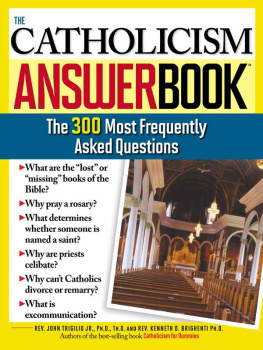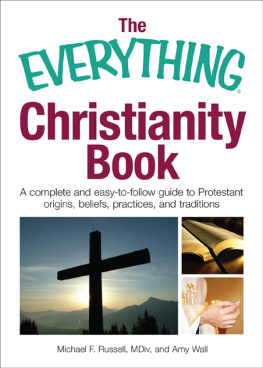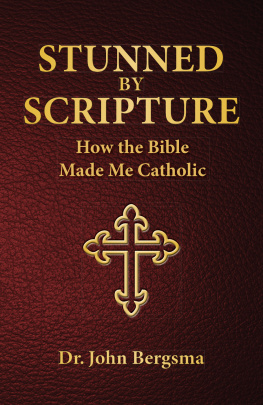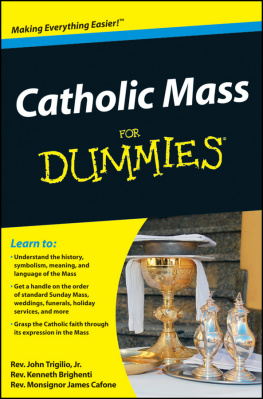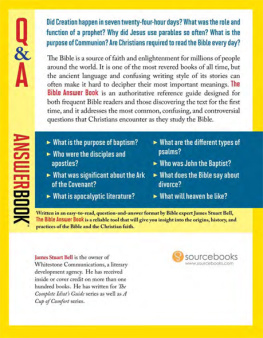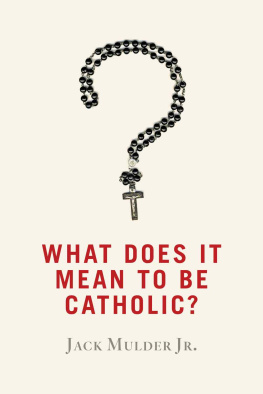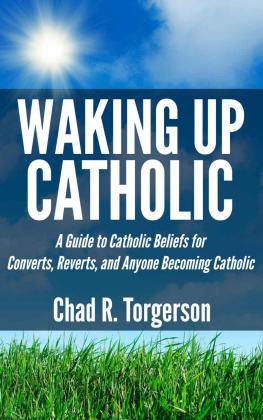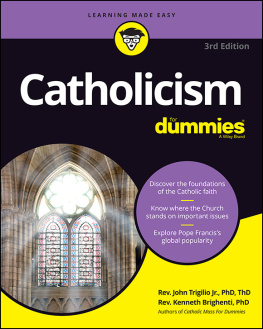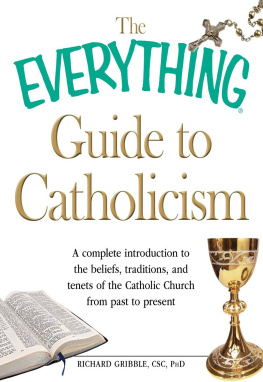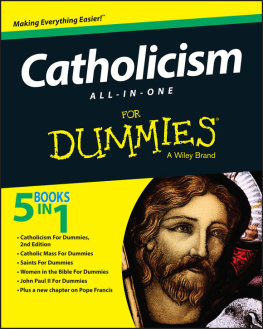
THE
Catholicism
Answer Book
The 300 Most Frequently Asked Questions
R EV . J OHN T RIGILIO J R ., P H D, T H D AND
R EVEREND K ENNETH B RIGHENTI , P H D

Copyright 2007 by Rev. Kenneth D. Brighenti, Ph.D., and Rev. John Trigilio, Jr., Ph.D.
Cover and internal design 2007 by Sourcebooks, Inc.
Cover photo Punchstock
Internal permissions Art Explosion 750,000
Sourcebooks and the colophon are registered trademarks of Sourcebooks, Inc.
All rights reserved. No part of this book may be reproduced in any form or by any electronic or mechanical means including information storage and retrieval systemsexcept in the case of brief quotations embodied in critical articles or reviewswithout permission in writing from its publisher, Sourcebooks, Inc.
This publication is designed to provide accurate and authoritative information in regard to the subject matter covered. It is sold with the understanding that the publisher is not engaged in rendering legal, accounting, or other professional service. If legal advice or other expert assistance is required, the services of a competent professional person should be sought. From a Declaration of Principles Jointly Adopted by a Committee of the American Bar Association and a Committee of Publishers and Associations
Published by Sourcebooks, Inc.
P. O. Box 4410, Naperville, Illinois 60567-4410
(630) 961-3900
Fax: (630) 961-2168
www.sourcebooks.com
Library of Congress Cataloging-in-Publication Data
Brighenti, Kenneth.
The Catholicism answer book : the 300 most frequently asked questions / Kenneth D. Brighenti and John Trigilio, Jr.
p. cm.
1. Catholic Church--Doctrines--Miscellanea. 2. Theology, Doctrinal--Popular works. I. Trigilio, John. II. Title.
BX1754.3.B75 2007
282--dc22
2006038963
Printed and bound in the United States of America.
VP 10 9 8 7 6 5 4 3
Nihil Obstat: Rev
. Msgnr. James M. Cafone, M. A., S.T.D.
Censor Librorum
December 20, 2007
Imprimatur: Most Rev. John J. Myers, D.D., J. C.D.
Archbishop of Newark
December 26, 2007
Feast of Saint Stephen, Protomartyr
The Nihil Obstat and Imprimatur are official declarations that a book or pamphlet is free of doctrinal or moral error. No implication is contained therein that those who have granted the Nihil Obstat and the Imprimatur agree with the content, opinions or statements expressed.
Dedication
This book is dedicated to the former Josef Cardinal Ratzinger, now His Holiness Pope Benedict XVI , the Vicar of Christ, Successor of Saint Peter, Bishop of Rome and Servant of the Servants of God. He and Pope John Paul the Great were our heroes during our seminary training and throughout our priesthood; to His Eminence Francis Cardinal Arinze , Prefect of Divine Worship and the Discipline of the Sacraments; to the Most Rev. Kevin C. Rhoades (Bishop of Harrisburg) and Reverend Mother Angelica (Abbess and founder of EWTN), Mother Vicar Catherine and all the Poor Clare Nuns of Perpetual Adoration at Our Lady of the Angels Monastery, Hanceville,AL ; to Rev. Fr. Robert Levis, PhD , for all his wisdom, knowledge, inspiration, counsel, advice, and most of all his holy example of priestly piety and staunch orthodoxy; and to all the faithful members of the Confraternity of Catholic Clergy .
In loving memory of His Holiness Pope John Paul II the Great, Doctor of Light, and of John Trigilio, Sr. (father), Mary Jo Trigilio (sister), Michael Trigilio (brother) and Joseph Trigilio (brother)
Acknowledgments
We would like to thank the following for their prayers and support throughout this project: our mothers (Norma Brighenti and Elizabeth Trigilio); father (Percy Brighenti); our friends (Lou & Sandy Falconeri, Drs. Keith & Christina Burkhart, MD, Thomas & Bridgette McKenna,Michael Drake,Doug Keck,Colin Donnovan, Stephen Beaumont, Noah Lett, Michael Warsaw, Ned & Lee South, Sam Ranelli) and especially the religious sisters and friars (Missionary Franciscans of the Eternal Word; Franciscan Friars of the Renewal; Fathers of Mercy; Religious Teachers Filippini, Villa Walsh, NJ; Discalced Carmelites Nuns of Erie, PA and Flemington, NJ; Dominican Nuns of the Perpetual Rosary, Lancaster, PA)
Contents
Section One: CreedCatholic Doctrine
Section Two: Why Seven Sacraments?Catholic Worship
Section Three: Which Ten?The Ten Commandments
Section Four: Our FatherOur Prayer
Section Five: Yesterday and Today: Church History and Common Questions
Section 1
C REED
C ATHOLIC
D OCTRINE
THIS SECTION HANDLES QUESTIONS ABOUT CATHOLIC
TEACHINGS (DOGMAS AND DOCTRINE).
Chapter 1
W HO I S G OD ?
This chapter looks at questions about God, the Trinity, and Creation.
Q uestion 1. How do we know there is a God?
Q uestion 2. Is God male, female, or neither?
Question 3. Why is the Holy Trinity not actually three gods?
Q uestion 4. Creation or evolution: which is it?
Q uestion 5. If God is all good, then why is there evil in the world?
Q uestion 6. Did God make the devil? And if he did, why?
Q uestion 7. What color (race) is God?
Q uestion 8. Did Creation actually take six days?
Q uestion 9. Do angels earn their wings?
Q uestion 10. If God created Eve from Adams rib, then why do men have the same number of ribs as women?
Q uestion 11. What was the original sin?
Q uestion 12. Did God create alien life on other planets?
Question 1. How do we know there is a God?
The most obvious question anyone asks a believer is How do you know God exists? Its a simple question that has both a simple and a complicated answer. First, the easy part: faith is believing in something or someone you cannot see or believing in what cannot be proven. In other words, faith depends on not having any evidence; otherwise, it would not be faith. So those who believe in God or in a supreme being are taking the word of others or just trusting their own instincts that such an almighty divinity does exist. Many people, whether they are Jewish, Christian, or Islamic, whether Roman Catholic, Eastern Orthodox, or Protestant, believe in God because they believe in the revealed Word of God, called Sacred Scripture or the Bible.
A more complicated answer is that Catholic Christianity does believe you can prove the existence of God. Reason can conclude that a supreme being exists and is necessary, but only faith (believing what cannot or is not known) tells us that there is but one God (monotheism). Judaism, Christianity, and Islam believe in only one God, and Christianity is the only of the three to believe that there are three Divine Persons in that one God. Human reason could never figure out the mystery of how there can be three persons but not three gods. Faith is needed to believe that doctrine, and some people never embrace that faith.
The fact that God exists can be known by reason alone, or it can be believed by faith. The ancient Greeks and Romans used philosophy (logic and reason) centuries before Christ to prove the existence of God or a supreme being. Saint Thomas Aquinas was a Catholic philosopher and theologian in the thirteenth century AD who used that same ancient reasoning to demonstrate the reasonableness of anyone knowing that God exists, regardless of whether or not they have faith. He showed that the existence of God can be proved by reason, but after that, one needed supernatural faith to believe the supernatural revelation about the nature of God (for example, the Trinity).
Next page
